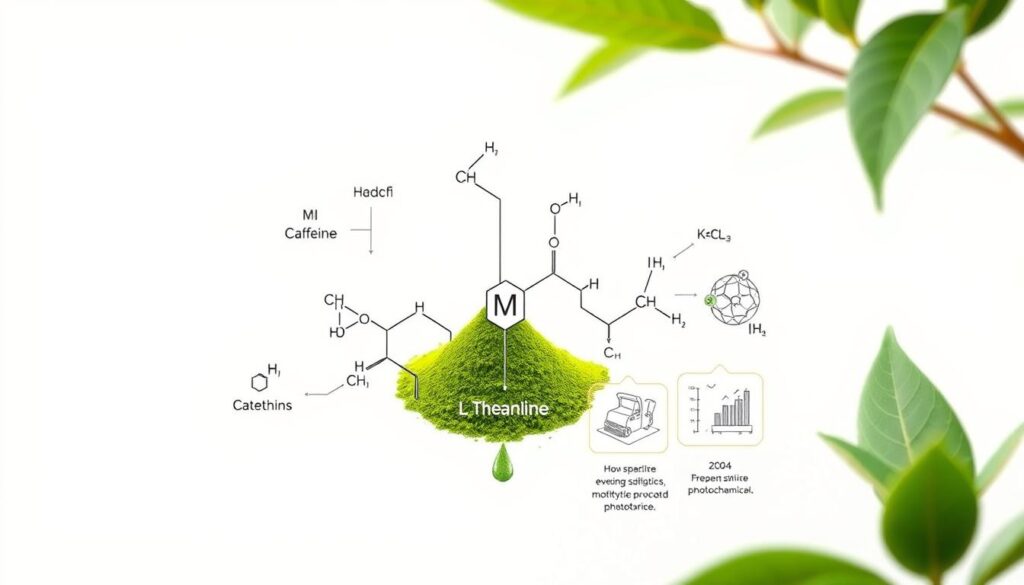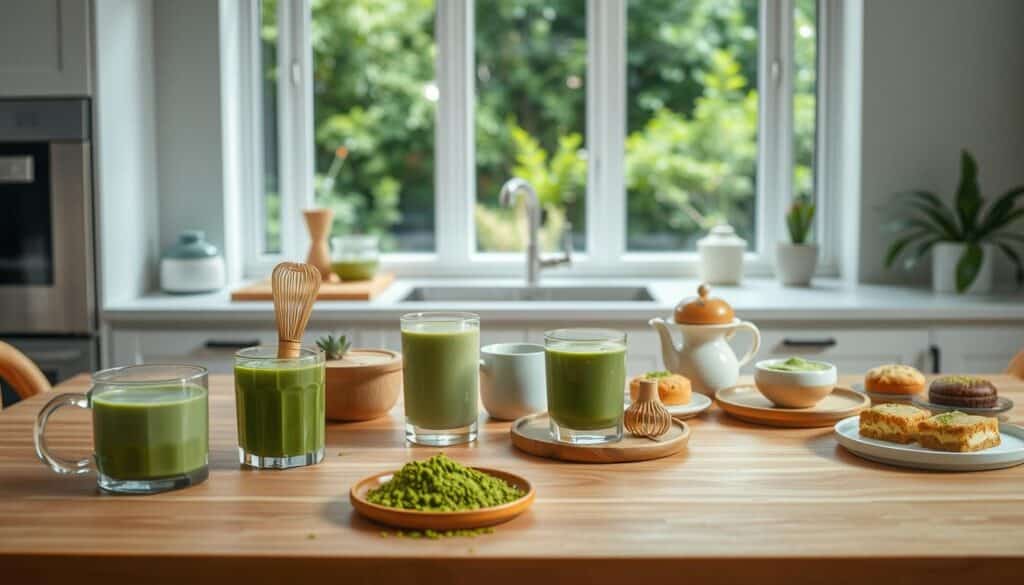Drinking matcha tea is a joyful morning ritual for me. Its bright green color, calming scent, and earthy taste connect me to old traditions. It also wakes up my body and mind, helping me stay present and calm.
The matcha plant is a key part of Japanese culture for hundreds of years. Unlike regular green tea, matcha lets us enjoy the whole leaf. This makes it packed with nutrients that help our hearts, manage weight, and boost overall health.
Matcha is full of antioxidants, like catechins, which fight cell damage and diseases. It also has caffeine and L-theanine, which help us relax and focus. Studies show matcha is good for our livers and helps us burn fat.
Let’s explore matcha’s health benefits together. You’ll see it’s more than just a drink—it’s a way to live healthier and more mindfully.
Key Takeaways
- The matcha plant is a unique form of green tea consumed as a powder, offering concentrated nutrients.
- Matcha is rich in catechins, providing strong antioxidant properties.
- The blend of caffeine and L-theanine in matcha enhances alertness while promoting relaxation.
- Consuming matcha can support liver health and reduce the risk of liver disease.
- Matcha aids in weight management by boosting metabolism and fat burning.
- The overall health benefits of matcha make it a valuable addition to a nutritious diet.
Want to learn more about matcha’s benefits? Check out more here.
What is Matcha?
Matcha is a finely ground powder from green tea leaves. It’s known for its bright color and special way of making. The magic of matcha comes from how it’s grown and made.
The Origin and Cultivation of Matcha
Matcha comes from Japan, where it’s been made for centuries. Tea plants are shaded for weeks before they’re picked. This makes the leaves green and rich in amino acids.
This results in a high-quality tea that tastes great and is good for you.
Unique Growing and Harvesting Techniques
*Ceremonial grade matcha* is special because of how it’s grown and picked. Leaves get more chlorophyll and L-theanine during shading. This makes matcha taste unique and helps you relax.
After picking, leaves are steamed, dried, and ground into powder. This careful process keeps the tea’s nutrients.
Matcha Powder vs. Green Tea
Matcha powder is different from regular green tea. You drink the whole leaf, not just the water it’s steeped in. This means you get more nutrients, like antioxidants and vitamins.
While green tea is good, matcha is more packed with nutrients. This is why it’s so popular.
| Aspect | Matcha Powder | Green Tea |
|---|---|---|
| Preparation | Ground into powder, whisked in water | Steeped leaves in water |
| Nutrient Intake | Whole leaf consumption (higher nutrients) | Leaf infusion (lower nutrients) |
| Flavor Profile | Rich, full, velvety | Light, fresh |
| Uses | Teas, lattes, smoothies, cooking | Teas |
In summary, matcha and green tea come from the same plant. But matcha’s special growing and making make it better in taste and nutrients. It’s a key part of wellness and spiritual living.
Chemical Composition of the Matcha Plant
Exploring matcha’s chemical makeup reveals its superfood status 🌿. It’s packed with catechins, caffeine, theanine, polyphenols, and phenolic acids. These compounds offer amazing health perks.
High Levels of Catechins
Matcha’s catechins, especially EGCG, are unique. They fight oxidative stress and inflammation. This makes matcha a powerhouse for health, more so than regular green tea.

Caffeine and Theanine Content
Matcha has caffeine, but it doesn’t make you jittery like coffee. The mix of caffeine and theanine boosts brain function. It keeps you alert and calm, without the crash.
Rich in Polyphenols and Phenolic Acids
Polyphenols and phenolic acids are key in matcha. They’re antioxidants that fight chronic diseases. These compounds make matcha a goldmine for health 💚.
| Component | Benefits |
|---|---|
| Catechins (EGCG) | Reduces oxidative stress and inflammation |
| Caffeine + Theanine | Enhanced brain function, calm focus |
| Polyphenols + Phenolic Acids | Antioxidant, reduces chronic disease risk |
For more on matcha’s nutritional benefits, check out this comprehensive guide.
Health Benefits of Matcha
Matcha is packed with nutrients that boost wellness. It’s a natural way to improve both physical and mental health.
Antioxidant Properties
Matcha is rich in antioxidants, especially catechins. These protect cells from damage. They fight oxidative stress and may lower disease risk.
Supporting Liver Health
Matcha is great for liver health. Studies show it can lower liver enzyme levels. This may protect against liver diseases like NAFLD.
Improving Brain Function
Matcha is good for brain health. It has caffeine and L-theanine. This mix boosts memory, attention, and reaction time. It’s great for mental clarity and focus.
Weight Management
Matcha helps with weight management. It boosts metabolism and fat burning. This makes it easier to manage weight.
How to Incorporate Matcha into Your Diet
Matcha is now a key ingredient in many dishes. It’s tasty and good for you. You can enjoy it in many ways, from traditional tea ceremonies to new recipes.

Traditional Matcha Tea Preparation
The matcha tea ceremony is a special way to enjoy matcha. You use a bamboo whisk to mix matcha with hot water. This makes a frothy, green tea.
This method helps you connect with the tea. It also lets you learn about its rich history.
Matcha Lattes and Smoothies
For a modern take, try matcha smoothies and lattes. Mix matcha with milk and sweeteners for a creamy drink. Add fruits and coconut water for a smoothie that’s both tasty and healthy.
Using Matcha in Cooking and Baking
Matcha adds a special flavor to many dishes. It’s great for breakfast or dessert. Sprinkle it in pancake batter or add it to cookies and cakes.
It’s also good in savory dishes like noodles or sauces. Matcha makes cooking fun and exciting.
To get ideas for cooking with matcha, check out this table:
| Recipe Type | Description | Matcha Usage |
|---|---|---|
| Matcha Latte | A creamy and comforting drink | Mix matcha powder with milk and a sweetener |
| Matcha Smoothie | A refreshing and nutritious blend | Blend matcha powder with fruits and greens |
| Matcha Pancakes | Fluffy green breakfast treats | Add matcha powder to batter |
| Matcha Cookies | Slightly sweet and earthy biscuits | Incorporate matcha into cookie dough |
Potential Side Effects and Considerations
Matcha is known for its health benefits. But, it’s good to know about possible side effects. The caffeine in matcha can make your heart beat faster or cause anxiety. If you’re sensitive to caffeine, drink it in moderation.
Also, non-organic matcha might have heavy metals. Choosing organic matcha can reduce these risks. This ensures a cleaner product. Learn more at Verywell Health.
If you’re pregnant, breastfeeding, or have a chronic condition, be careful. Matcha might affect certain medications or health issues. To avoid risks, pick trusted brands. For quality suggestions, see Trader Joe’s Matcha Powder. Being informed helps you enjoy matcha safely. 🌿


